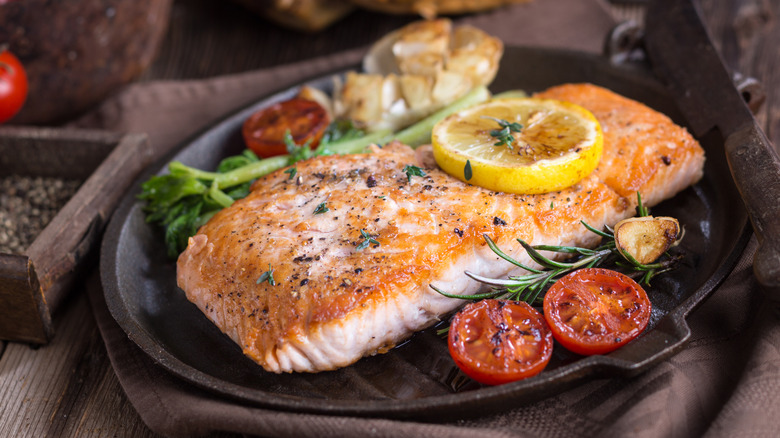When Reheating Salmon, Low And Slow Is The Way To Go
Salmon is a great dinner idea, but leftovers can also make a fantastic lunch if reheated properly. The fish keeps its quality for three to four days if put in an airtight container in the fridge. Despite the stigma around reheating seafood — mostly due to its fishy smell — it's safe to reheat salmon. However, you should ditch the microwave to ensure best results. While you may be tempted to speed up the process, it's best to slow things down when reheating salmon.
For best results, it's recommended that you reheat your salmon in the oven. Rather than try to cook things quickly over high heat, you should settle for a slow cook at a low temperature. Heat your oven to no higher than 300 degrees Fahrenheit. While the concept of slow cooking may conjure memories of those long days of cooking a roast for hours, reheating salmon is faster than that. It should only take about 15 minutes to reheat your salmon, and you'll avoid the high heat of the microwave.
Reheating your fish at the right temperature is important because salmon has delicate meat that can easily ruin. High temperatures can have disastrous consequences on the quality of your seafood.
High temperatures can ruin fish
One of the pitfalls of reheating salmon is that you risk overcooking your fish because you are essentially cooking the dish twice. One of the reasons you should avoid using high temperatures to flash-fry your fish is that it can turn your filet into a dry, chewy husk. When heated at a high temperature, the proteins within the salmon begin to shrink — think of a rope being frayed. As the salmon's proteins denature, it ruins the soft delicate meat of the fish. High temperatures also dry up much of the moisture inside of your salmon, which may be fine if you're making salmon jerky but not if you want to maintain the quality of your fish.
However, if you are hoping to save time, then there is a quicker way to reheat salmon without sacrificing quality. You can always toss it in the air fryer. Let your fish cook at 350 degrees for around four to five minutes. If you're using an air fryer, add a little water to the bottom of the basket to prevent your filet from overcooking. However, the oven is still the recommended method for reheating salmon as it ensures the best results.
Other tips to follow when reheating salmon
Besides cooking your salmon on low heat, you should also do your best to protect your filet from the direct heat of the oven. Aluminum foil acts as a great buffer, ensuring that your salmon cooks evenly and preventing cold spots in the middle of your fish. You shouldn't tightly cover your filet as it might stick to the foil. Instead, put a loose layer of foil over your fish before reheating it.
Likewise, reheating your salmon is a battle of moisture, but unlike sailors on a sinking ship, you want to retain as much of it as possible. Fortunately, there are a few things you can do before reheating your fish to make sure it doesn't lose too much moisture. First, rub your salmon with a thin layer of olive oil, which acts as a barrier against moisture loss. Also, consider adding a small amount of water to your pan before adding your salmon. The resulting steam will keep your fish moist.
Finally, if you're planning on reheating salmon, it's best that you cook the filet properly to start with. If you accidentally overcook your fish the first time, there's little that you can do to help your leftovers. Keep an eye on your salmon's internal temperature and remove it from the oven once it reaches the desired level of doneness.


